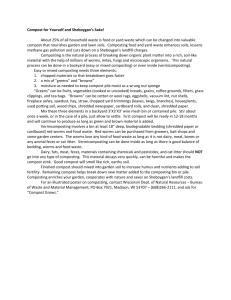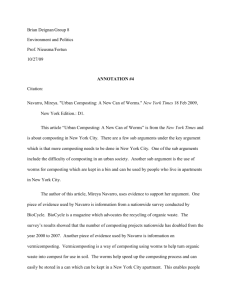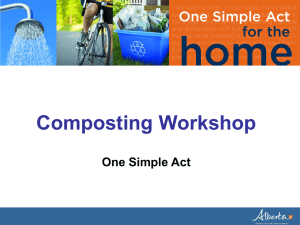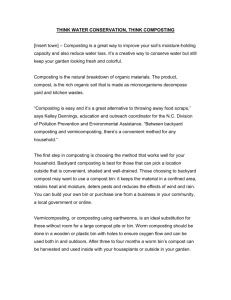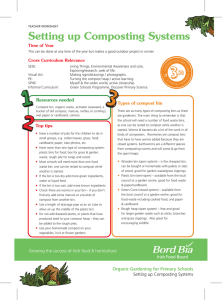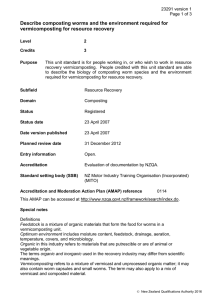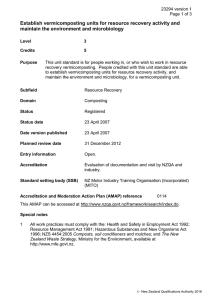Composting 101 - Science
advertisement
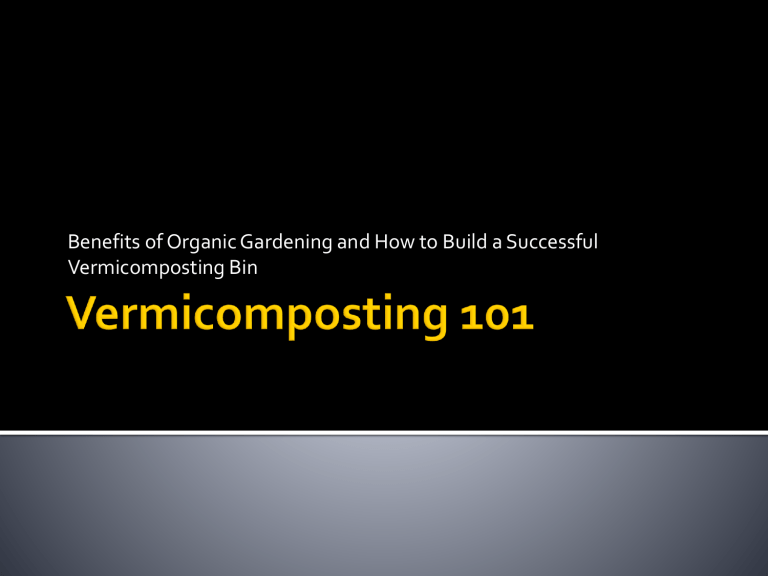
Benefits of Organic Gardening and How to Build a Successful Vermicomposting Bin Benefits of Composting Types of Composters Short Garden Tour (Weather Permitting) How-to: Vermicompost Build your own bin Questions? Reduce or eliminate the need for chemical fertilizers. Promote higher yields of agricultural crops. Cost-effective Avoids Methane and leachate formulation in landfills. Healthier plants Better for your body Reduces the need for water, fertilizers, and pesticides. Carbon: Nitrogen Ration 30:1 (Basically, you need more brown than green) Carbon “Browns”: Ashes, wood Bark Cardboard, shredded Corn stalks Leaves Newspaper, shredded Peanut shells Peat moss Pine needles Sawdust Stems and twigs, shredded Straw Vegetable stalks Nitrogen “Greens” Alfalfa Algae Clover Coffee grounds Food waste Garden waste Grass clippings Hay Hedge clippings Hops, used Manures Seaweed Vegetable scraps Weeds* Backyard Composting Open Bin Closed Bin Vermicomposting Indoor (Kitchen) Composting Red Wigglers They don’t burrow Eat half their body weight Put a pound of worms in (about 1000 worms), then they’ll eat ½ pound of food/day They’re hermaphroditic Can be used as bait for fishing Ordered from Living Science at Region 20, online, or bait shops Worms eat recycled food scraps As the worms eat, the food becomes compost It exits the worms body through the tail end Worm “tea” is left over and can be used as soil amendments Find a storage bin with a loose fitting lid or one with holes in the lid Cover the bottom with a carbon base Newspaper Dry leaves Add vegetables and some fruit Leave in a cool, dark place Drain leachate when you see it forming at the bottom Do: Add food scraps once/week or as needed Leave in a dark environment Drain leachate once it gets full at the bottom (once you can see it puddling) Don’t: Add meat, dairy, oily foods Leave in full sun Leave the lid open (they’ll leave!) Please leave your email with us! Like us on FB “Harris Middle School Community Garden” Follow us on instagram “harrisgarden” Follow us on twitter “harrisgarden” Worm Composting Basics Vermicomposting http://www.epa.gov/waste/conserve/tools/greenscapes/pubs/compost-guide.pdf Cornell Compost Science http://www.organicgardeningguru.com/composting-101/carbon-nitrogen-ratio/ Guide to Composting http://www.epa.gov/compost/ http://whatcom.wsu.edu/ag/compost/fundamentals/needs_placement_structures.htm Organic Gardening Basics http://home.howstuffworks.com/vermicomposting1.htm Composting for Facilities Basics http://compost.css.cornell.edu/worms/basics.html http://compost.css.cornell.edu/physics.html Composting Science – Univ. of Illinois http://web.extension.illinois.edu/homecompost/science.cfm


